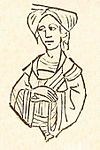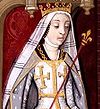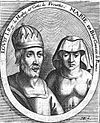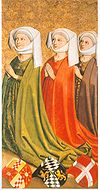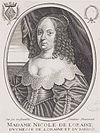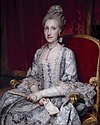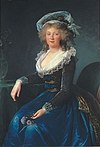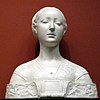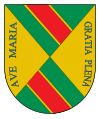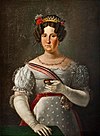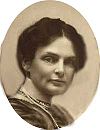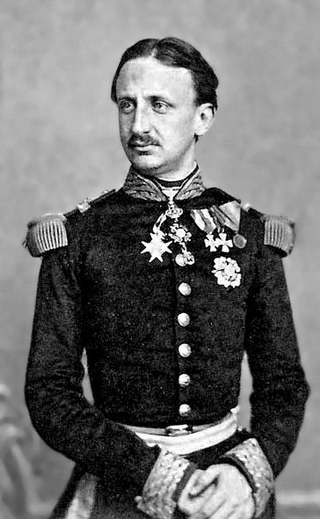
Francis II was King of the Two Sicilies. He was the last King of the Two Sicilies as successive invasions by Giuseppe Garibaldi and Victor Emmanuel II of Sardinia ultimately brought an end to his rule, as part of Italian unification. After he was deposed, the Kingdom of the Two Sicilies and the Kingdom of Sardinia were merged into the newly formed Kingdom of Italy.

Francis I of the Two Sicilies was King of the Two Sicilies from 1825 to 1830 and regent of the Kingdom of Sicily from 1806 to 1814.

Maria Isabella of Spain was Queen of the Two Sicilies from 4 January 1825 until 8 November 1830 as the wife of Francis I of the Two Sicilies.

Don Carlos María Alfonso Marcelo de Borbón-Dos Sicilias y Borbón-Parma, Infante of Spain, Duke of Calabria was, at his death, the last male infante of Spain during the reigns of his cousins King Juan Carlos I and King Felipe VI.

Duke of Calabria was the traditional title of the heir apparent of the Kingdom of Naples after the accession of Robert of Naples. It was also adopted by the heads of certain Houses that had once claimed the Kingdom of Naples in lieu of the royal title.

Prince Ferdinand Pius, Duke of Calabria and Castro, was head of the House of Bourbon-Two Sicilies and pretender to the throne of the extinct Kingdom of the Two Sicilies from 1934 to 1960.

The House of Bourbon-Two Sicilies is a cadet branch of the House of Bourbon that ruled Southern Italy and Sicily for more than a century in the 18th and 19th centuries. It descends from the Capetian dynasty in legitimate male line through Philip, Duke of Anjou, a younger grandson of Louis XIV of France (1638–1715) who established the Bourbon dynasty in Spain in 1700 as Philip V (1683–1746). In 1759, King Philip's younger grandson was appanaged with the kingdoms of Naples and Sicily, becoming Ferdinand IV and III (1751–1825), respectively, of those realms. His descendants occupied the joint throne, merged as the "Kingdom of the Two Sicilies" in 1816, until 1861, claimed it thereafter from exile, and constitute the extant Bourbon-Two Sicilies family.
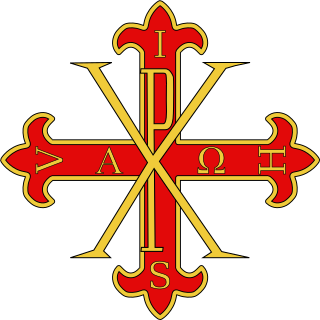
The Sacred Military Constantinian Order of Saint George, also historically referred to as the Imperial Constantinian Order of Saint George and the Order of the Constantinian Angelic Knights of Saint George, is a dynastic order of knighthood of the House of Bourbon-Two Sicilies. Currently, the grand magistry of the order is disputed among the two claimants to the headship of the formerly reigning House of Bourbon-Two Sicilies as heirs of the House of Farnese, namely Prince Pedro and Prince Carlo. The order was one of the rare orders confirmed as a religious-military order in the papal bull Militantis Ecclesiae in 1718, owing to a notable success in liberating Christians in the Peloponnese. Together with the Sovereign Military Order of Malta, it is one of a small number of Catholic orders that still have this status today. It is not an order of chivalry under the patronage of the Holy See, but its membership is restricted to practising Catholics.

Prince Carlo of Bourbon-Two Sicilies, Duke of Castro is one of the two claimants to the headship of the former House of Bourbon-Two Sicilies.
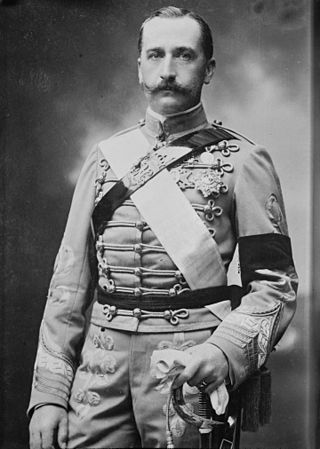
Don Carlos, Prince of Bourbon-Two Sicilies, Infante of Spain was the son of Prince Alfonso of the Two Sicilies, Count of Caserta and his wife Princess Maria Antonietta of Bourbon-Two Sicilies, and nephew of the last King of the Two Sicilies, Francis II.

Princess Anne of Bourbon-Two Sicilies, Dowager Duchess of Calabria, born Princess Anne of Orléans, is the widow of Infante Carlos, Duke of Calabria. She is the third daughter and fifth child of Henri, Count of Paris, Orléanist claimant to the defunct French throne, and his wife Princess Isabelle of Orléans-Braganza.

Maria Clementina of Austria was an Austrian archduchess and the tenth child and third daughter of Leopold II, Holy Roman Emperor and Maria Luisa of Spain. In 1797 she married her double first cousin Prince Francis, Duke of Calabria, heir to the kingdoms of Naples and Sicily. She was modest, well educated and kind, becoming popular in her adoptive country. Afflicted with frail health, she died of tuberculosis, age twenty four. Her only surviving child was Princess Caroline, Duchess of Berry.
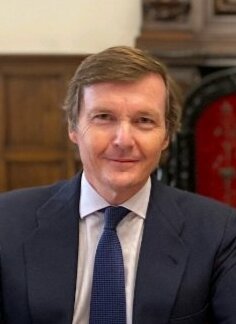
Prince Pedro of Bourbon-Two Sicilies, Duke of Calabria, Grandee of Spain, is the only son of Infante Carlos, Duke of Calabria (1938–2015), and his wife, Princess Anne of Orléans. As primogeniture heir of the kings of the Two Sicilies he is the principal claimant to the headship of the Royal House of Bourbon-Two Sicilies, which ruled the Kingdom of the Two Sicilies before the unification of Italy.
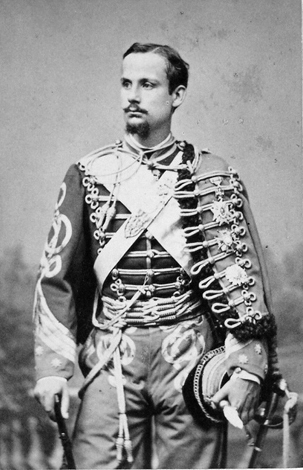
Prince Gaetan of the Two Sicilies, Count of Girgenti was the seventh child of Ferdinand II of the Two Sicilies and his wife Maria Theresa of Austria. Gaetan was a member of the House of Bourbon-Two Sicilies and consort to Isabella, Princess of Asturias, twice the recognized heir presumptive to the throne of Spain. Through this union, Gaetan was created an Infante of Spain.

Charles III of Spain is the third surviving son of the first Bourbon King of Spain Philip V and Elisabeth Farnese. The descendants of Charles III of Spain, are numerous. Growing up in Madrid till he was 16, he was sent to the Italian Sovereign Duchy of Parma and Piacenza which, through his mother Elisabeth of Parma, was considered his birthright. Charles married only once, to the cultured Princess Maria Amalia of Saxony, with whom he had 13 children; 8 of these reached adulthood and only 4 of these had issue.
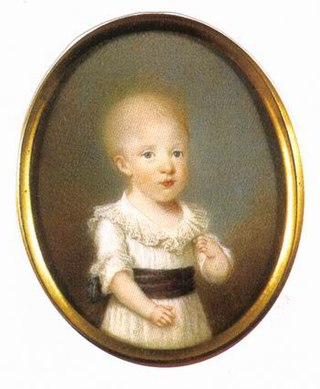
Prince Giuseppe of Naples and Sicily was the first "Prince of Naples and Sicily". The title was later conferred by Joseph Bonaparte to be hereditary on his children and grandchildren.

Prince Alberto of Naples and Sicily was a Prince of Naples and Sicily as the youngest son of King Ferdinand I of the Two Sicilies and his wife Maria Carolina of Austria. He died aged six near Palermo, Sicily, during a storm on board HMS Vanguard, a British Royal Navy warship, whilst his family was fleeing, under the care of Admiral Lord Nelson, from Napoleonic troops approaching Naples.


